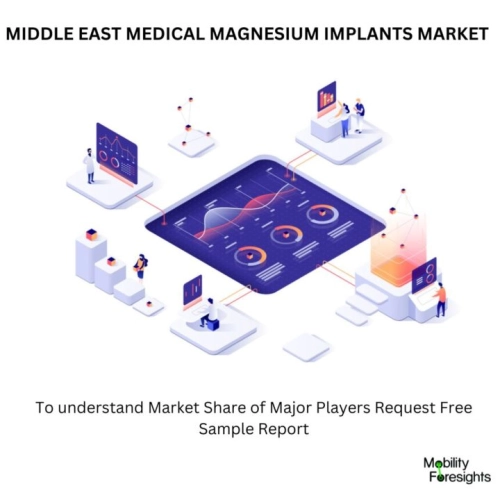
- Get in Touch with Us

Last Updated: Apr 25, 2025 | Study Period:
MIDDLE EAST MEDICAL MAGNESIUM IMPLANTS MARKET
KEY FINDINGS:
The Middle East Medical Magnesium Implants Market is growing as healthcare providers and patients in the region seek advanced medical technologies that can improve surgical outcomes and reduce recovery times. Magnesium implants, known for their biodegradability and biocompatibility, are becoming increasingly popular, especially in the fields of orthopedics and cardiovascular care. The regionâs focus on enhancing its healthcare infrastructure and embracing new medical innovations is creating opportunities for the adoption of these advanced implants.
Magnesium implants are widely used for their unique ability to degrade naturally in the body over time. This eliminates the need for secondary surgeries to remove the implants, which is a significant advantage for both patients and healthcare providers. Applications range from orthopedic devices like screws and plates for bone fixation to cardiovascular stents that can support blood vessels during healing. As the population ages and lifestyle diseases increase, the demand for such innovative implants is expected to grow.
However, the market is not without challenges. Regulatory hurdles can delay the introduction of new products, and there is still a need for more clinical evidence to support the long-term benefits of magnesium implants. Nonetheless, continued investments in research, development, and clinical trials are expected to address these challenges, further enhancing the growth potential of the Middle East Medical Magnesium Implants Market.
The Middle East Medical Magnesium Implants Market encompasses the development, use, and distribution of bioresorbable magnesium implants in medical applications. These implants, made from magnesium alloys, offer significant advantages in surgeries due to their ability to degrade and be absorbed by the body, removing the need for implant removal surgeries. The market is growing rapidly, especially in countries like Saudi Arabia and the UAE, which are investing heavily in healthcare modernization.
Different types of magnesium implants are available in the market, including orthopedic devices such as screws, plates, and pins for bone fracture repair, as well as cardiovascular stents used in treating arterial blockages. These implants provide flexibility for surgeons and are well-suited for various types of surgeries, making them an attractive alternative to traditional titanium or steel implants.
The benefits of magnesium implants are numerous, including their biocompatibility and reduced need for follow-up procedures. However, there are challenges in ensuring the right degradation rate to match the healing process and maintaining implant strength over time. Additionally, regulatory approval processes in the Middle East can be slow, but increasing efforts are being made to streamline these approvals to promote medical innovation.

| Company Name | Product Description | Analyst View |
| Syntellix AG | Bioresorbable magnesium-based orthopedic screws and plates for fracture repair | Expected to gain traction in the Middle East due to the demand for minimally invasive and bioresorbable implants. |
| Biotronik | Magnesium-based cardiovascular stents for treating arterial blockages | Well-positioned to capture market share as cardiovascular diseases rise in the region. |
| Zimmer Biomet | Magnesium fixation devices for orthopedic trauma and joint stabilization | Anticipated to grow in popularity with increasing aging population and demand for innovative orthopedic solutions. |
| Acumed LLC | Magnesium-based small bone fixation devices | Likely to see adoption in trauma and sports-related surgeries across the Middle East. |
| U&I Corporation | Pediatric magnesium implants designed for bone fixation in children | Poised for growth as awareness about bioresorbable implants in pediatric care increases. |
| Sr No | Toc |
| 1 | Market Segmentation |
| 2 | Scope of the Report |
| 3 | Research Methodology |
| 4 | Executive Summary |
| 5 | Introduction |
| 6 | Average B2B Price |
| 7 | Regional Analysis and Trends |
| 8 | Impact of Technological Advancements on the Middle East Medical Magnesium Implants Market |
| 9 | Demand Technology Trends in the Industry |
| 10 | Major Key Drivers in the Market |
| 11 | Recent Product Developments |
| 12 | Manufacturing Footprint for Major Players |
| 13 | Recent Orders in the Middle East Medical Magnesium Implants Market |
| 14 | Market Dynamics and Strategic Initiatives |
| 15 | Analysis of Middle East Medical Magnesium Implants Market Initiatives on Market Growth |
| 16 | Impact of Sustainable Practices on Market Trends |
| 17 | Market Size, Dynamics, and Forecast by Product Type, 2024-2030 |
| 18 | Market Size, Dynamics, and Forecast by Application, 2024-2030 |
| 19 | Market Size, Dynamics, and Forecast by End-User, 2024-2030 |
| 20 | Market Size, Dynamics, and Forecast by Country, 2024-2030 |
| 21 | Pricing Strategies and Market Positioning |
| 22 | Competitive Landscape |
| 23 | M&A in the Past 12 Months |
| 24 | Growth Strategy of Leading Players |
| 25 | Market Share of Vendors, 2024 |
| 26 | Company Profiles |
| 27 | Unmet Needs and Opportunity for New Suppliers |
| 28 | Conclusion |